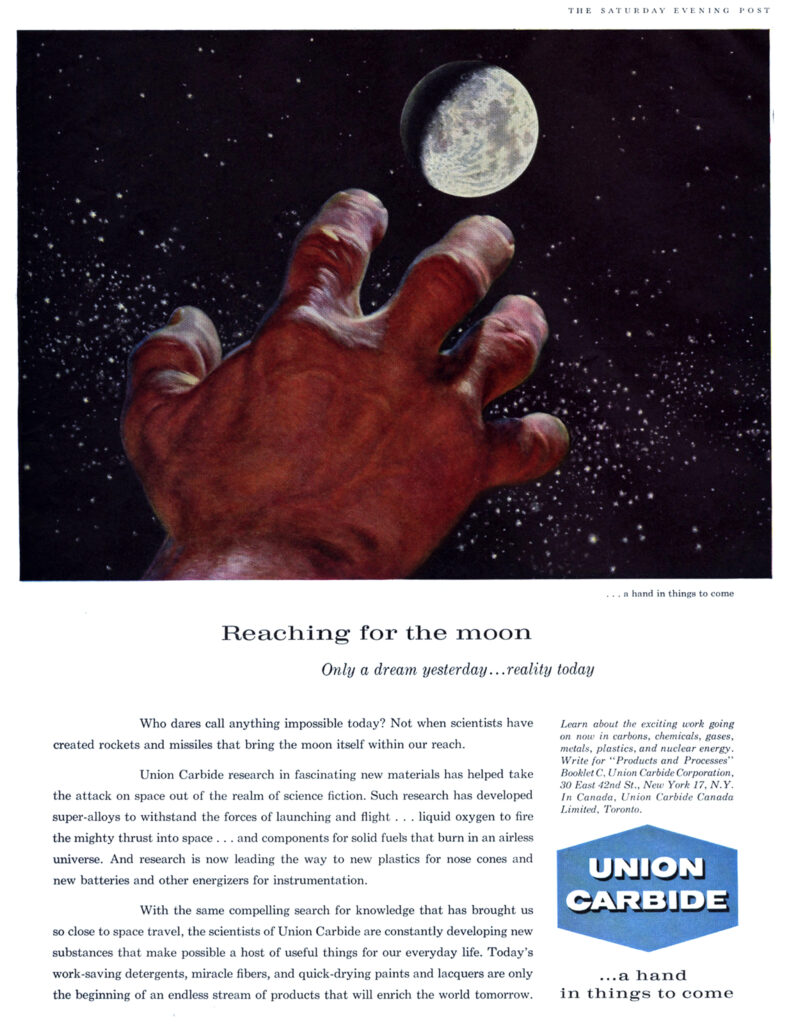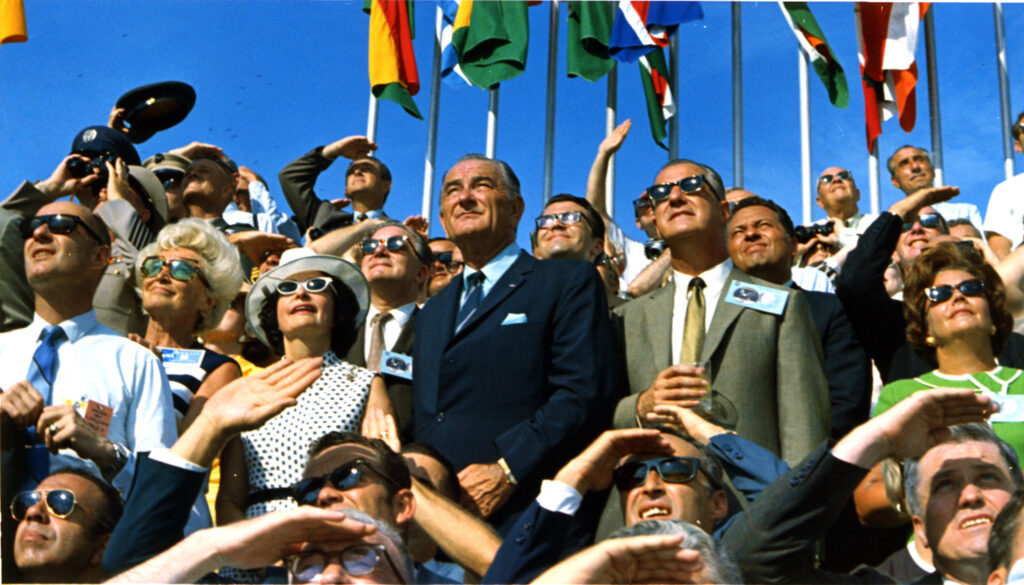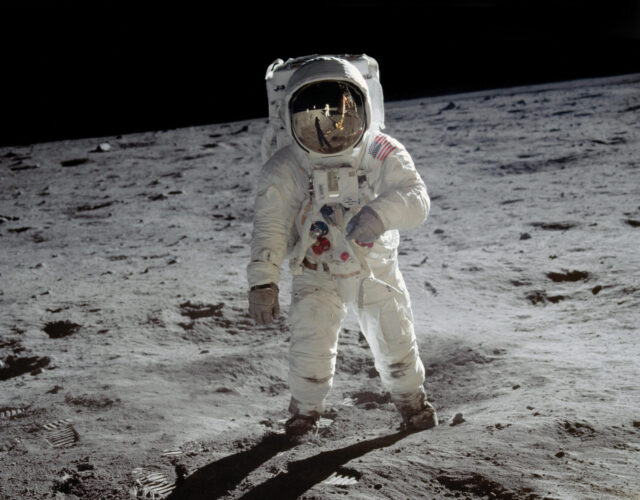David Meerman Scott and Richard Jurek. Marketing the Moon: The Selling of the Apollo Lunar Program. MIT Press, 2014. 144 pp. $39.95.
NASA’s Apollo program, with its landing of six two-man crews on the lunar surface, is one of the best-remembered technological endeavors of the 20th century. And why shouldn’t it be? The seemingly impossible plan to land a man on the moon and bring him back alive was announced in 1961 by a president whose fame only grew following his assassination two-and-a-half years later. The success of Apollo 11 in 1969, and the insistence that it was done “for all mankind” and not as part of Cold War competition with the Soviet Union, has retrospectively been painted as a moment of unity in an otherwise fractured decade. And despite evidence to the contrary, the Apollo program is often presented as having enjoyed nearly universal support from the American public. These aspects of the Apollo story have been reproduced ad nauseam in books and in television and film adaptations.
But the real reasons we remember Apollo—even for those of us too young to have witnessed it firsthand—have as much to do with the many images of the program as they do with its legitimate technological and scientific achievements. Broadcasters, entertainers, contractors, and advertisers, as well as NASA and the astronauts themselves, produced a host of photos and illustrations, all of which contributed to the cultural understanding of the Apollo astronaut as lunar explorer. Consider, for example, the powdered orange drink Tang, made popular by its association with the space program. NASA provided manufacturers with almost unrestricted use of the photos the space agency produced, as long as advertising copy did not imply NASA’s endorsement. In the case of Tang, advertisers used photographs of astronauts, along with the fact that they carried Tang on their missions, to aggressively promote the idea that Apollo astronauts drank Tang in space—although NASA wouldn’t allow the advertisers to say this in so many words. The marketing was so successful that consumers came to believe the drink had been developed specifically for space travel, even though it had been available and advertised before the space program began.
Tang advertisements and much more can be found in Marketing the Moon, a portmanteau of glossy coffee-table book and historical monograph. It combines reproductions of the art, illustrations, and advertisements that promoted the lunar program with analysis of the successes and failures of the marketing strategies created by NASA, its contractors, and companies trying to turn a profit off the space craze.
The book’s authors are not the first to address the subject, but David Meerman Scott, a marketing strategist, and Richard Jurek, a marketing and public-relations (PR) executive, bring a novel perspective to the scholarship—what they describe as “the lens of practicing PR and marketing professionals”—and unearth some rarely seen promotional materials culled from private collections. Jurek and Scott are themselves Apollo enthusiasts and collectors, and their love of NASA’s early manned programs shines through in their treatment of the subject.

But while Scott and Jurek celebrate Apollo—a product, as they see it, that practically sold itself—they are critical of NASA’s failure to develop a long-term marketing strategy once the novelty of the initial moon landings wore off. Given the expense of early spaceflight and the magnitude of political will required to pull it off, NASA’s program demanded high levels of public support. But NASA failed to form a consistently organized or thoughtful approach to media relations. Rather, the communication styles and rapport with reporters that developed at the various NASA centers were products of the personalities and philosophies of the public-information personnel working at the centers.
In short, NASA as an organization put minimal thought into how to sell the lunar program to the public, working instead under the assumption that the public was interested, would remain interested, and would best be served by large quantities of unfiltered and unspun information. While the news media appreciated NASA’s approach (reporters like Walter Cronkite who enjoyed nearly unlimited access to the information coming out of NASA quickly became space buffs), the general public (where space buffs existed but were not the majority) quickly lost interest. With each successive moon landing after Apollo 11, the public paid less and less attention, and the television networks provided less coverage, with the exception of Apollo 13’s dramatic brush with disaster.
Perhaps ironically, the public was seeing less and less of the Apollo television footage from the moon just as camera technology and know-how were improving from mission to mission. One of the best chapters in the book from a history-of-technology standpoint, “The Whole World Is Watching: Live TV on Apollo,” chronicles not only the evolution of the relationship between Apollo and the television networks but also the development of the television technology that went to the moon. Readers probably remember the iconic grainy footage of Neil Armstrong and Edwin “Buzz” Aldrin’s first moonwalk but may never have seen the incredible color footage shot during Apollo 17, the program’s final mission.
Designing camera equipment that worked on the moon was daunting: temperatures range from 250°F in the sun to -250°F in the shade. Operating cameras with the gloves of a space suit was its own challenge. Nonetheless, Westinghouse and RCA developed color-television cameras that could survive the temperature extremes, be operated by astronauts or by a controller on the ground, and, in the words of Apollo public-affairs officer Doug Ward as quoted in the book, provide “just a beautiful way for the public to watch over the shoulder and to absorb all the activities on the Moon.” For the Apollo 15 mission—the first to use cameras mounted on the lunar rover and controlled from the ground—the equipment worked beautifully, and the networks carried much of the lunar activities live. Aside from the Apollo 11 footage, this imagery is the best remembered of the Apollo program. But the technology’s success did not keep the public engaged; the networks cut coverage for the two remaining Apollo missions, believing that the novelty of watching astronauts walk and work on the lunar surface had worn off.
The authors blame NASA and its partners for failing to keep the public and the news media interested in astronauts’ further exploits. Not only did Congress curtail future Apollo missions to the moon, NASA failed to convince the public that its later space-shuttle program was heroic or adventurous. “In our analysis,” the authors write, “the reason humans have not been to Mars is, essentially, the result of a marketing failure.” Epic adventure was supplanted by geology and traveling rock exhibitions, then by scientists working in space, and the public moved on.
NASA’s Apollo program, with its landing of six two-man crews on the lunar surface, is one of the best-remembered technological endeavors of the 20th century.
In assigning blame the authors point to NASA’s hubris. NASA and its astronauts took for granted that the tide of history was with them. At the end of the book the authors quote astronaut Alan Bean: “People are going to keep going, we’re going to build bases on the Moon, we’re going to go to Mars. Just figure out how to do it and then we’ll go do it. We don’t need to convince anybody to like it, because we liked it.” NASA’s failure to convince the public that human exploration should continue was a missed opportunity—one Scott and Jurek describe in marketing terms: “Reversing the inevitable downturn in a product’s life cycle is one of the most difficult jobs marketers face. As with countless product marketers who have failed to revitalize a fading brand, NASA wasn’t able to overcome the declining interest after the tremendous success of Apollo 11.” The authors do hold out hope, however, that more marketing-savvy entrepreneurs—perhaps Elon Musk and Richard Branson, both of whom are briefly profiled in the book—will be able to capture public enthusiasm where NASA has failed and make spaceflight cool again.
Here the authors’ single-minded focus on advertising and PR may have blinded them to other factors keeping NASA from sending humans to Mars or back to the moon. The Apollo program was designed to send humans to the moon for political, not scientific, reasons, and could never have become a sustainable solar-system exploration program. Moreover, the program required an incredible amount of political will. In his recent book After Apollo? Richard Nixon and the American Space Program, historian John Logsdon points out the Nixon administration’s lack of interest in continuing Apollo-style exploration. Instead, the administration opted for a more affordable exploration program, even as it reaped the publicity and goodwill of Apollo’s earlier successes.

The authors also ignore the successful robotic missions that have been exploring the solar system since before the days of Apollo. These, especially the rovers that have allowed planetary scientists to study the surface of Mars without the costs or hazards of sending humans, have enjoyed public support and attention. At the Smithsonian National Air and Space Museum where I work, the three Mars rovers on display are very popular among visitors. The Pathfinder lander and its Sojourner rover even made cameo appearances in the recent film The Martian. This hardware may not have the same sex appeal as Matt Damon, but it has taught the public a great deal about Mars and engaged them in Mars exploration in a way that the prospect of a costly manned mission has yet to accomplish. Moreover, these rovers and the larger exploration program in which they exist will form the scientific and technological basis for any human missions that may follow.
Scott and Jurek want to see human exploration continue. Their book collects for the first time the variety of images that helped shape American understanding of the astronaut as explorer. And the authors use these images to make a strong argument for NASA’s need to engage the public, if only to justify the large expenditures needed to continue human forays into the solar system. But the two may overstate the inherent value or marketability of human space exploration. When referring to Apollo’s achievements, for example, they reproduce unquestioned the hyperbolic claims surrounding Apollo 8’s famous picture of Earth from space. They write, uncritically, that people watching the footage from home were transformed when “the very idea of what it was to be a human inhabitant on the planet Earth changed” and that the mission “united humanity in a singular moment.” They also take many of their interview subjects’ accounts at face value, reproducing astronaut Eugene Cernan’s claim that NASA wasn’t trying to market or create heroes but rather astronauts became heroes only as a consequence of their work. The result, ironically, is a missed opportunity to examine fully the ways in which NASA worked to craft the astronauts’ public image.




